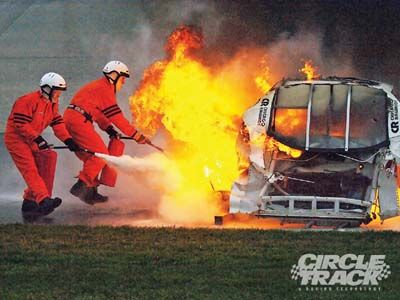
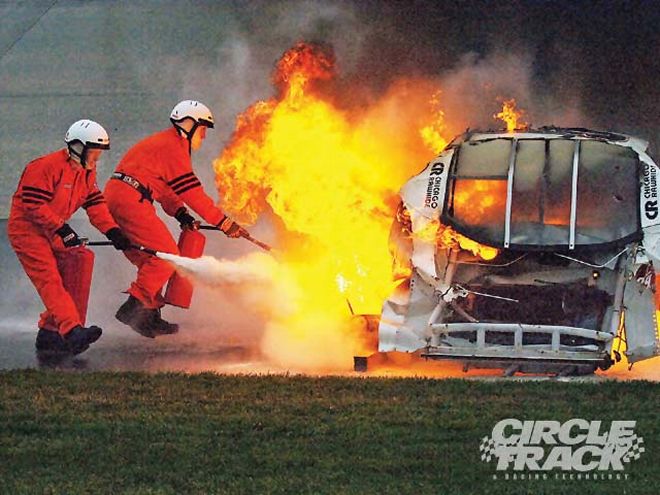
When you're looking for standards on how safety equipment should be manufactured (seatbelts, firesuits, gloves, and so on), you look to the SFI Foundation. When you're looking for helmet standards, you look toward the Snell Foundation. But when a racetrack is looking to what safety equipment it needs to have on hand and putting together a plan in case of an emergency, where does it look?
During the Society of Automotive Engineers Motorsports Engineering Conference held last year in Charlotte, North Carolina, a segment of the safety panel included Daniel Jones, Fire Chief of the Chapel Hill, North Carolina, fire department. His talk focused on how a motorsports facility, of any size, can be prepared for most any emergency situation. He referenced a guide that all racetracks should use to organize their safety programs, called the NFPA 610, published by the National Fire Protection Association.
To provide a little history, back in 1999 The National Fire Protection Association sat down with the major sanctioning bodies to develop a guide to help motorsports facilities provide the safest environment for their events. The document is designed to be both broad in scope and flexible to accommodate the largest superspeedway and smallest parking lot go-kart track.
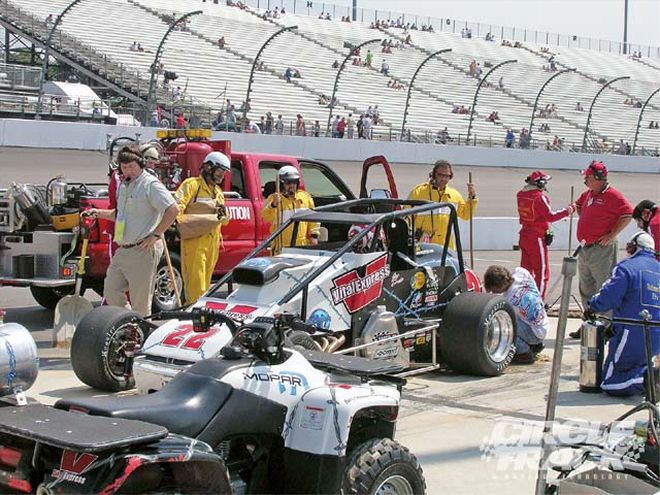 A well-trained safety crew is a big step in ensuring a safe work environment for race teams at the track.
A well-trained safety crew is a big step in ensuring a safe work environment for race teams at the track.
As you read this article, you may think, I'm a crewmember, how does this affect me? Well, it's your safety that the guide is designed to protect. The guide may be written for the use of the track owners and sanctioning bodies, but it's the race team's responsibility to make sure that the tracks where they race are using the best practices to maintain that safety.
As an example of the importance of the NFPA 610 guide, here's a list of questions that a track owner or sanctioning body should be able to answer.
1. Does your track have the proper fire fighting chemicals to extinguish the racing fuels seen at this track?
2. To what hospitals will injured be transported?
3. How will the track handle race operations in the event all ambulances have to be used to transport injured to hospitals?
4. What skill level of medical personnel are on site during the event?
5. Where will additional fire fighting/ MS/traffic control extraction support come from if required?
6. Does the track crew have equipment capable of cutting rollbars and race car body structure? (Equipment used for passenger car extraction is not always capable of use in race car incidents)
7. Is the track crew trained in extractions from the type of vehicles run at this track?
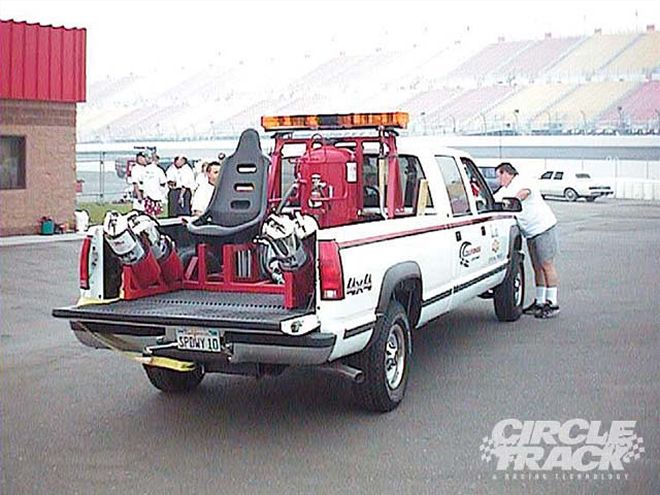 This California Speedway safety truck would look out of place at most of America's short tracks.
This California Speedway safety truck would look out of place at most of America's short tracks.
The way the track owners are able to answer those questions is with the Emergency Action Plan detailed in the guide. The EAP is the centerpiece of the guide. It's the emergency preparedness of facilities that first got the NFPA involved with the motorsports venues. Working through the EAP forces those involved to look at their facility and personnel and answer the questions ahead of time before they need to be addressed at a future critical time.
The EAP covers such major areas as: the size of the event, traffic control, fire protection, hazardous materials, and communications. The guide includes a sample EAP so that a facility can see what types of information and levels of detail are required to have a complete plan.
Another major component of the guide is training. The training section defines specific levels of knowledge and responsibility that can define a motorsports safety worker by level.
The levels of safety crewmembers are:1. Motorsports Safety Awareness2. Motorsports Safety Operations3. Motorsports Safety Technician4. Motorsports Safety Specialist5. Motorsports Safety Command Manager
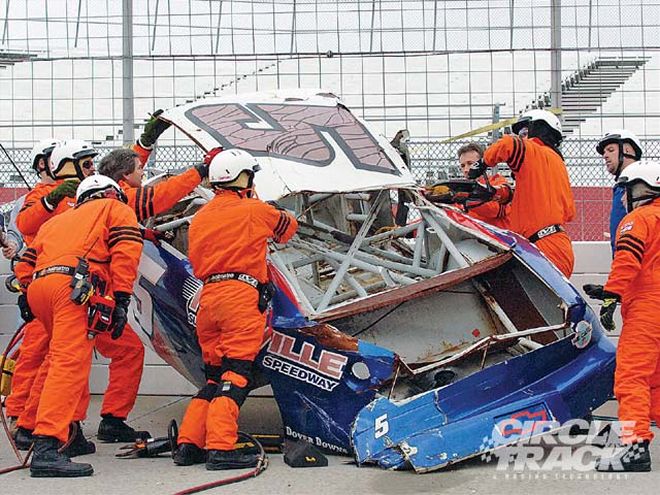 Training is essential for a safety crew to stay at the top of its game. Here, Dover Speedway Safety personnel take part in a training exercise.
Training is essential for a safety crew to stay at the top of its game. Here, Dover Speedway Safety personnel take part in a training exercise.
Each higher level (from Awareness to Specialist) adds more specific skills and more specialized training. The command manager, as the name suggests, is in a management role to command and direct emergency response actions while having information about the facility, its EAP, external emergency resources, and civil authorities.
To get an inside look at motorsports safety training, we also spoke with Jennifer Butler and Heather Rehm, who are members of the safety crew for the Checkered Flag Sprint Series based in Tampa, Florida. Their class was held at a local racetrack and consisted of two days of instruction. The instruction was both classroom oriented and hands-on practical.
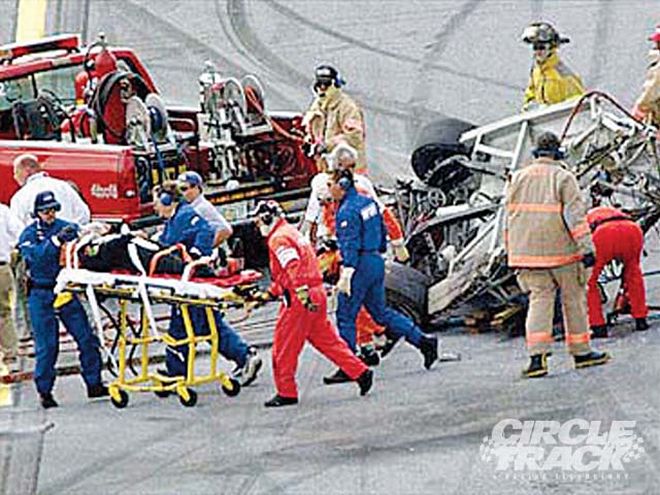 A first-class safety crew helps ensure Geoff Bodine's survival in his horrific crash in the NASCAR Truck Series at Daytona in 2000.
A first-class safety crew helps ensure Geoff Bodine's survival in his horrific crash in the NASCAR Truck Series at Daytona in 2000.
The classroom instruction included a video of previous accidents and how the rescue crews responded to them. The responses of the safety crews are then reviewed as to what went right and wrong. The class instruction also included firefighters teaching proper techniques about extinguishing fires, and discussions about the differences between gasoline and alcohol fires. Additionally included in the classroom sessions were instructions on how to describe different types of accidents, accident cleanup, and basic hand signals of safety crews. The most important concept taught during the class was keeping track crew safe while working an accident scene.
The hands-on instruction allowed the students to put into practice many of the concepts they learned in the classroom. In the first part, one of the class members was placed into a car and the class practiced extracation using a backboard. The class also practiced putting out fires, and understanding the difficulties in identifying and extinguishing alcohol fires. The basic layout of different cars was shown and the general process of turning off the engine and shutting off the fuel were taught. The class also used the proper cutting tools to remove a car's roof and cut through rollbars. In addition, the class discussed when and why to cut the car, and to avoid cutting unless it was absolutely necessary. The class that Jennifer and Heather attended ended with a test to show what they had learned.
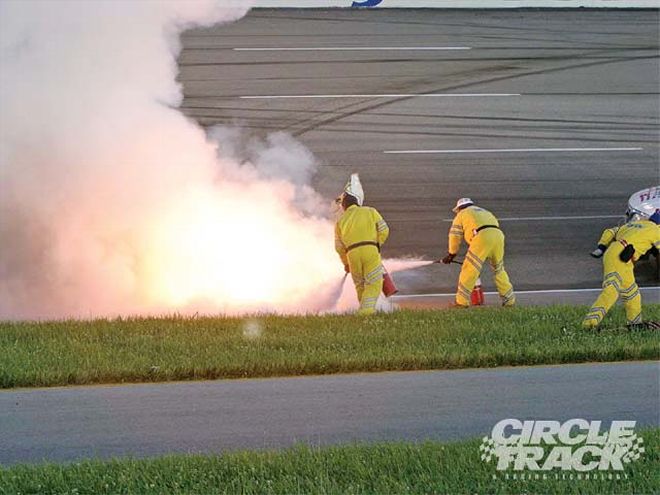 Lots of smoke is the end result of the successful fire fighting event.
Lots of smoke is the end result of the successful fire fighting event.
We hope that race teams and race drivers take the precautions to ensure their safety, but when it's out of their control it falls on the track safety crew to use its training and predefined procedures to ensure the safety of the race facility. Having EMS, fire, and rescue personnel on hand for a race event is a must, but making sure they are trained as to the differences between street vehicles and race vehicles is the determining factor in the care they will provide to the racers.
The knowledge is out there for any facility. The NFPA 610 is a very well-written document that details the procedures for a motorsports facility to become best prepared for most emergency situations. Ask your track owner today whether or not he knows about NFPA 610 and if he doesn't, tell him where to get it.